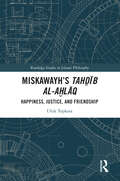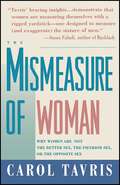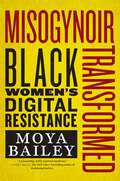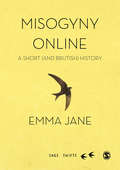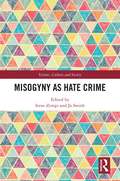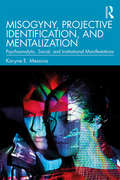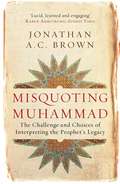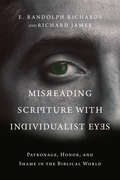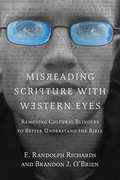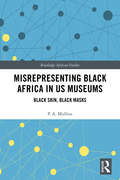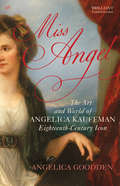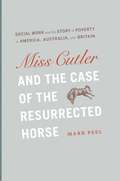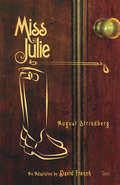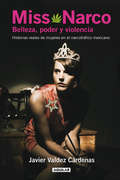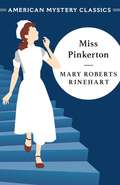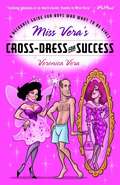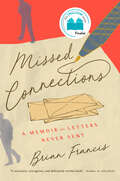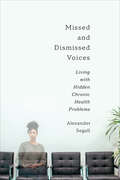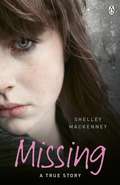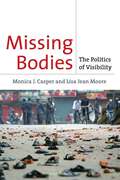- Table View
- List View
Miskawayh's Tahḏīb al-aḫlāq: Happiness, Justice and Friendship (Routledge Studies in Islamic Philosophy)
by Ufuk TopkaraThis book engages with the work of Miskawayh, a formative Islamic Philosopher in the 11th century, who is acknowledged as the founder of Islamic Moral Philosophy. Miskawayh’s The Refinement of Character (Tahḏīb al-Aḫlāq) draws from both ancient Greek philosophical tradition and Islamic thought, highlighting the concepts he integrated into what he argued to be the moral core of Islam. This book pursues a comparative study by analyzing and outlining the inherent philosophical concerns of the Aristotelian concepts of Happiness, Justice and Friendship, which are then brought into conversation with Miskawayh’s own concepualizations of them. While Tahḏīb al-Aḫlāq is deeply influenced by Aristotle’s ethics, Miskawayh employs not only a Platonizing interpretation of Aristotelian philosophy, but also incorporates traditions of Islamic thought. The study therefore concludes that Miskawayh is merely a transmitter of ancient Greek philosophy, as shown by both his critical survey of the material available to him and his own critical contributions. Essentially, Miskawayh attempted to harmonize philosophical and religious concepts of knowledge, demonstrating the interlinking of what are perceived as—at times detrimentally—incompatible positions. Ufuk Topkara illustrates how Aristotle’s Ethics are integrated, modified and at times adjusted to the broader narrative of Islamic thought and how Miskawayh’s discourse, albeit philosophical in nature, remains religious in its outlook. Providing clear insight into Miskawayh’s work, this book is ideal for students and scholars of Islamic Philosophy and Muslim Theology.
Mismatch: How Inclusion Shapes Design (Simplicity: Design, Technology, Business, Life)
by Kat HolmesHow inclusive methods can build elegant design solutions that work for all.Sometimes designed objects reject their users: a computer mouse that doesn't work for left-handed people, for example, or a touchscreen payment system that only works for people who read English phrases, have 20/20 vision, and use a credit card. Something as simple as color choices can render a product unusable for millions. These mismatches are the building blocks of exclusion. In Mismatch, Kat Holmes describes how design can lead to exclusion, and how design can also remedy exclusion. Inclusive design methods—designing objects with rather than for excluded users—can create elegant solutions that work well and benefit all.Holmes tells stories of pioneers of inclusive design, many of whom were drawn to work on inclusion because of their own experiences of exclusion. A gamer and designer who depends on voice recognition shows Holmes his “Wall of Exclusion,” which displays dozens of game controllers that require two hands to operate; an architect shares her firsthand knowledge of how design can fail communities, gleaned from growing up in Detroit's housing projects; an astronomer who began to lose her eyesight adapts a technique called “sonification” so she can “listen” to the stars.Designing for inclusion is not a feel-good sideline. Holmes shows how inclusion can be a source of innovation and growth, especially for digital technologies. It can be a catalyst for creativity and a boost for the bottom line as a customer base expands. And each time we remedy a mismatched interaction, we create an opportunity for more people to contribute to society in meaningful ways.
Mismeasure of Woman: Why Women are Not the Better Sex, the Inferior Sex, or the Opposite Sex
by Carol TavrisWhen "man is the measure of all things," woman is forever trying to measure up. In this enlightening book, Carol Tavris unmasks the widespread but invisible custom -- pervasive in the social sciences, medicine, law, and history -- of treating men as the normal standard, women as abnormal. Tavris expands our vision of normalcy by illuminating the similarities between women and men and showing that the real differences lie not in gender, but in power, resources, and life experiences. Winner of the American Association for Applied and Preventive Psychology's Distinguished Media Contribution Award
Misogynoir Transformed: Black Women’s Digital Resistance (Intersections #18)
by Moya BaileyWhere racism and sexism meet—an understanding of anti-Black misogynyWhen Moya Bailey first coined the term misogynoir, she defined it as the ways anti-Black and misogynistic representation shape broader ideas about Black women, particularly in visual culture and digital spaces. She had no idea that the term would go viral, touching a cultural nerve and quickly entering into the lexicon. Misogynoir now has its own Wikipedia page and hashtag, and has been featured on Comedy Central’s The Daily Show and CNN’s Cuomo Prime Time. In Misogynoir Transformed, Bailey delves into her groundbreaking concept, highlighting Black women’s digital resistance to anti-Black misogyny on YouTube, Facebook, Tumblr, and other platforms. At a time when Black women are depicted as more ugly, deficient, hypersexual, and unhealthy than their non-Black counterparts, Bailey explores how Black women have bravely used social-media platforms to confront misogynoir in a number of courageous—and, most importantly, effective—ways. Focusing on queer and trans Black women, she shows us the importance of carving out digital spaces, where communities are built around queer Black webshows and hashtags like #GirlsLikeUs. Bailey shows how Black women actively reimagine the world by engaging in powerful forms of digital resistance at a time when anti-Black misogyny is thriving on social media. A groundbreaking work, Misogynoir Transformed highlights Black women’s remarkable efforts to disrupt mainstream narratives, subvert negative stereotypes, and reclaim their lives.
Misogyny
by David D. Gilmore"Yes, women are the greatest evil Zeus has made, and men are bound to them hand and foot with impossible knots by God."--Semonides, seventh century B.C.Men put women on a pedestal to worship them from afar--and to take better aim at them for the purpose of derision. Why is this paradoxical response to women so widespread, so far-reaching, so all-pervasive? Misogyny, David D. Gilmore suggests, is best described as a male malady, as it has always been a characteristic shared by human societies throughout the world.Misogyny: The Male Malady is a comprehensive historical and anthropological survey of woman-hating that casts new light on this age-old bias. The turmoil of masculinity and the ugliness of misogyny have been well documented in different cultures, but Gilmore's synoptic approach identifies misogyny in a variety of human experiences outside of sex and marriage and makes a fresh and enlightening contribution toward understanding this phenomenon. Gilmore maintains that misogyny is so widespread and so pervasive among men that it must be at least partly psychogenic in origin, a result of identical experiences in the male developmental cycle, rather than caused by the environment alone.Presenting a wealth of compelling examples--from the jungles of New Guinea to the boardrooms of corporate America--Gilmore shows that misogynistic practices occur in hauntingly identical forms. He asserts that these deep and abiding male anxieties stem from unresolved conflicts between men's intense need for and dependence upon women and their equally intense fear of that dependence. However, misogyny, according to Gilmore, is also often supported and intensified by certain cultural realities, such as patrilineal social organization; kinship ideologies that favor fraternal solidarity over conjugal unity; chronic warfare, feuding, or other forms of intergroup violence; and religious orthodoxy or asceticism. Gilmore is in the end able to offer steps toward the discovery of antidotes to this irrational but global prejudice, providing an opportunity for a lasting cure to misogyny and its manifestations.
Misogyny Online: A Short (and Brutish) History (SAGE Swifts)
by Emma A. JaneMisogyny Online explores the worldwide phenomenon of gendered cyberhate as a significant discourse which has been overlooked and marginalised. The rapid growth of the internet has led to numerous opportunities and benefits; however, the architecture of the cybersphere offers users unprecedented opportunities to engage in hate speech. A leading international researcher in this field, Emma A. Jane weaves together data and theory from multiple disciplines and expresses her findings in a style that is engaging, witty and powerful. Misogyny Online is an important read for students and faculty members alike across the social sciences and humanities.
Misogyny Re-Loaded
by Abigail BrayBlending personal experience with rigorous study, this explosive manifesto rails against what it presents as the resurgent sexual fascism of the new world order. By exposing everything from the casual acceptance of snuff pornography in "gore" culture to the framing of rape as a punch line, Abigail Bray links the celebration of sexual sadism to the rise of an authoritarian culture of militarized violence. Arguing that a meaningful collective resistance has been undermined by the mass destruction of genuine social and economic security for ordinary women, Misogyny Re-loaded presents a scathing critique of a politically convenient, billionaire-friendly, mainstream brand of feminism. Drawing on a wide range of resources from popular culture, literature, economics, psychiatry, psychology, philosophy, and environmental science, this book offers a warning about the growing social and environmental threat of an out-of-control military industrial complex.
Misogyny as Hate Crime (Victims, Culture and Society)
by Irene Zempi Jo SmithMisogyny as Hate Crime explores the background, nature and consequences of misogyny as well as the legal framework and UK policy responses associated with misogyny as a form of hate crime. Taking an intersectional approach, the book looks at how experiences of misogyny may intersect with other forms of hate crime such as disablism, Islamophobia, antisemitism and transphobia. From the sexist and derogatory comments about women by former US President Donald Trump, to legislative changes in Chile and Peru making street harassment illegal, misogyny presents a challenge to scholars, practitioners, policy makers, and women globally. The increasing importance of the internet has seen misogyny move into these digital spaces but has also provided a platform for movements such as #MeToo and #TimesUp, highlighting the scale of sexual harassment and abuse. In 2016, Nottinghamshire Police in partnership with Nottingham Women’s Centre became the first force in England and Wales to record misogyny as a hate crime. Since then other police forces have introduced similar schemes to tackle misogyny. More recently, the Law Commission of England and Wales has undertaken a review of the legislation on hate crime and in their consultation paper of proposals for reform have suggested ‘adding sex or gender to the protected characteristics’. In March 2021, the Government announced that police forces in England and Wales will be required to record crimes motivated by hostility based on sex or gender from this autumn. The murder of Sarah Everard has been a ‘watershed moment’ in the Government’s response to violence against women. Sarah Everard’s kidnap and murder who went missing while walking home from a friend’s flat in South London on 3 March 2021, ignited a national conversation about violence against women. Against this background, the book speaks both to the proposed reforms of the hate crime legislation around misogyny, and the broader issues around experiences of and legal responses to misogyny. It showcases the work of leading scholars in this area alongside that of activists and practitioners, whose work has been invaluable in opening up public discussion on misogynistic hate crime and encouraging wider social change. In recognising the intersections of different forms of prejudice, the book provides an innovative contribution to these ‘hate debates’, highlighting the complexities of creating separate strands of hate crime. Providing a comprehensive understanding of the debates around inclusion of misogyny as a form of hate crime, this ground-breaking book will be of great interest to students, scholars and activists interested in gender, hate crime, feminism, criminology, law, policing and sociology.
Misogyny, Projective Identification, and Mentalization: Psychoanalytic, Social, and Institutional Manifestations
by Karyne E. MessinaMisogyny, Projective Identification, and Mentalization looks at how the psychoanalytic concepts of projective identification and mentalization may explain the construction of society and how they have enabled misogyny to be expressed in social, political, and institutional settings. Karyne E. Messina explores how misogyny has affected the perception and treatment of women through analysis of a range of examples of individual women and groups. The first part explores projective identification as a mechanism for the suppression of women, looking at the origins of the concept in psychoanalysis and its expansion. The author examines the story of Clara Thompson as an example, arguing that her virtual disappearance from the history of psychiatry and psychoanalysis itself is a telling example of this process at work. The second part of the book uses four examples of individuals, including the recent election loss by Hillary Clinton in 2016, to show that projective identification can (particularly in political and cultural settings) overtake and motivate groups as well as individuals, and lead to violence, atrocity, humiliation, and dismissal of and against women. Part three then features case studies of four groups of women from the 20th century, including victims of the 1994 Rwandan genocide, showing how projective identification against groups has occurred. With specific reference to the erasure of women’s contributions in society, both individually and collectively, and the trauma that arises from the many effects of regarding women as a group as "less" or "other", this is a book which sets a new agenda for understanding how misogyny is expressed socially. Misogyny, Projective Identification, and Mentalization will be of interest to psychoanalysts and psychoanalytic psychotherapists as well as scholars of politics, gender, and cultural studies.
Misogyny, Toxic Masculinity, and Heteronormativity in Post-2000 Popular Music (Palgrave Studies in (Re)Presenting Gender)
by Glenn Fosbraey Nicola PuckeyThis book presents chapters that have been brought together to consider the multitude of ways that post-2000 popular music impacts on our cultures and experiences. The focus is on misogyny, toxic masculinity, and heteronormativity. The authors of the chapters consider these three concepts in a wide range of popular music styles and genres; they analyse and evaluate how the concepts are maintained and normalized, challenged, and rejected. The interconnected nature of these concepts is also woven throughout the book. The book also seeks to expand the idea of popular music as understood by many in the West to include popular music genres from outside western Europe and North America that are often ignored (for example, Bollywood and Italian hip hop), and to bring in music genres that are inarguably popular, but also sit under other labels such as rap, metal, and punk.
Misquoting Muhammad: The Challenge And Choices Of Interpreting The Prophet's Legacy (Islam in the Twenty-First Century)
by Jonathan A. C. BrownFew things provoke controversy in the modern world like the religion brought by Muhammad. Modern media are replete with alarm over jihad, underage marriage and the threat of amputation or stoning under Shariah law. Sometimes rumor, sometimes based in fact and often misunderstood, the tenets of Islamic law and dogma were not set in the religion’s founding moments. They were developed over centuries by the clerical class of Muslim scholars. Misquoting Muhammad takes the reader back in time through Islamic civilization and traces how and why such controversies developed, offering an inside view into how key and controversial aspects of Islam took shape. From the protests of the Arab Spring to Istanbul at the fall of the Ottoman Empire, and from the ochre red walls of Delhi’s great mosques to the trade routes of Islam’s Indian Ocean world, Misquoting Muhammad lays out how Muslim intellectuals have sought to balance reason and revelation, weigh science and religion, and negotiate the eternal truths of scripture amid shifting values.
Misreading Scripture with Individualist Eyes: Patronage, Honor, and Shame in the Biblical World
by Richard James E. Randolph RichardsThe Bible was written within collectivist cultures. When Westerners, immersed in individualism, read the Bible, it's easy to misinterpret important elements—or miss them altogether. In any culture, the most important things usually go without being said. So to read Scripture well we benefit when we uncover the unspoken social structures and values of its world. We need to recalibrate our vision. Combining the expertise of a biblical scholar and a missionary practitioner, Misreading Scripture with Individualist Eyes is an essential guidebook to the cultural background of the Bible and how it should inform our reading. E. Randolph Richards and Richard James explore deep social structures of the ancient Mediterranean—kinship, patronage, and brokerage—along with their key social tools—honor, shame, and boundaries—that the biblical authors lived in and lie below the surface of each text. From Abraham, Sarah, and Hagar to Peter's instructions to elders, the authors strip away individualist assumptions and bring the world of the biblical writers to life. Expanding on the popular Misreading Scripture with Western Eyes, this book makes clear how understanding collectivism will help us better understand the Bible, which in turn will help us live more faithfully in an increasingly globalized world.
Misreading Scripture with Western Eyes: Removing Cultural Blinders to Better Understand the Bible
by E. Randolph Richards Brandon J. O'BrieneconomicSome readers might assume that Moses married "below himself" because his wife was a dark-skinned Cushite. Actually, Hebrews were the slave race, not the Cushites, who were highly respected. Aaron and Miriam probably thought Moses was being presumptuous by marrying "above himself."Western individualism leads us to assume that Mary and Joseph traveled alone to Bethlehem. What went without saying was that they were likely accompanied by a large entourage of extended family.
Misrepresenting Black Africa in U.S. Museums: Black Skin, Black Masks (Routledge African Studies)
by P.A. MullinsThis book is an examination of race, Black African objects, identity, museums at the turn of the 19th century in the U.S. via the history of the earliest collectors of Black African objects in the U.S.. Misrepresenting Black Africa in American Museums explores black identity as a changing, nuanced concept. Focusing on racial history in the United States, this book examines two of the earliest collectors of Black African objects in the United States. First, there is a history of race and ideas of primitiveness is presented. Next, there is a discussion of western concepts of race. Then there is an examination of Karl Steckelmann, the first collector who is a united states citizen. After which there is a critical account of William H. Sheppard, the second collector who is also a black Presbyterian Minister from Virginia. Then a broader discussion of public appearances of Black African images in public. This is followed by a detailed look at museum formation and practices. Next, there is a theoretical discussion of identity and race, and finally, a look at the impact of historical practices that continue into the 21st century. This book will be of interest to scholars of race and racism, African visual culture, heritage and museum studies.
Miss Aluminium: ONE OF THE SUNDAY TIMES' 100 BEST SUMMER READS OF 2020
by Susanna MooreONE OF THE SUNDAY TIMES' 100 BEST SUMMER READS OF 2020'Unlike any Hollywood memoir you'll have read' Metro'It's hard to beat Susanna Moore's Miss Aluminium' Vogue'A sharp-edged summery treat' Hadley FreemanAt seventeen, Susanna Moore left her home in Hawai'i, with no money, no belongings and no prospects. But in Philadelphia, an unexpected gift of four trunks of beautiful clothes allowed her to assume the first of many disguises. Her journey takes her from New York to Los Angeles where she becomes a model and meets Joan Didion and Audrey Hepburn. She works as a script reader for Warren Beatty and Jack Nicholson, and is given a screen test by Mike Nichols. But beneath Miss Aluminium's glittering fairytale surface lies the story of a girl's insatiable hunger to learn. Moore gives us a sardonic, often humorous portrait of Hollywood in the seventies and of a young woman's hard-won arrival at selfhood.
Miss Angel: The Art and World of Angelica Kauffman, Eighteenth-Century Icon
by Angelica GooddenA word was coined to describe the condition of people stricken with a new kind of fever when the Swiss-born artist Angelica Kauffman (1741-1807) came to London in 1766. 'The whole world', it was said, 'is Angelicamad.' One of the most successful women artists in history - a painter who possessed what her friend Goethe called an 'unbelievable' and 'massive' talent - Kauffman became the toast of Georgian England, captivating society with her portraits, mythological scenes and decorative compositions. She knew and painted poets, novelists and playwrights, collaborating with them and illustrating their work; her designs adorned the houses of the Grand Tourists she had met and painted in Italy; actors, statesmen, philosophers, kings and queen sat to her; and she was the force that launched a thousand engravings. Despite rumours of relationships with other artists (including Sir Joshua Reynolds), and an apparently bigamous and annulled first marriage to a pseudo Count, Kauffman was adopted by royalty in England and abroad as a model of social and artistic decorum. A profoundly learned artist, but one who is loved, above all, for her tender adaptations from classical antiquity and sentimental literature; a commercially successful celebrity yet also a founding member of The Royal Academy of arts; the virginal creator of sexually ambivalent beings who was one of the hardest-headed businesswomen of her age, Kauffman's life and work is full of apparent contradictions explored in this first biography in over 80 years.
Miss Cutler & the Case of the Resurrected Horse
by Mark PeelSocial workers produced thousands of case files about the poor during the interwar years. Analyzing almost two thousand such case files and traveling from Boston, Minneapolis, andaPortland to London and Melbourne, "Miss Cutler and the Case of the Resurrected Horse" is a pioneering comparative study that examines how these stories of poverty were narrated and reshaped by ethnic diversity, economic crisis, and war. Probing the similarities and differences in the ways Americans, Australians, and Britons understood and responded to poverty, Mark Peel draws a picture of social work that is based in the sometimes fraught encounters between the poor and their interpreters. He uses dramatization to bring these encounters to lifeOCojoining Miss Cutler and that resurrected horse are Miss Lindstrom and the fried potatoes and Mr. OOCONeil and the seductive clientOCoand to give these people a voice. Adding new dimensions to the study of charity and social work, this book is essential to understanding and tackling poverty in the twenty-first century.
Miss Julie
by David French August StrindbergDavid French's adaptation of August Strindberg's disturbing and enduring drama of the transgressive affair between the daughter of a count and the count's man-servant has an eerie contemporary feel about it. French has sharpened the psychodramas of the original - scenes of desire, anger, jealousy, coercion, manipulation, exploitation, arrogance, dominance, submission, and deceit. Cast of 2 women and 1 man.
Miss Narco
by Javier Valdez CárdenasTestimonios conmovedores y terribles de mujeres que, por decisión propia o por azares del destino, vivieron las consecuencias de encontrarse cara a cara con el mundo del narcotráfico. De Javier Valdez Cárdenas, Premio Internacional a la Libertad de Expresión, el autor de Los morros del narco. Obra finalista del Premio Rodolfo Walsh. Belleza, poder y violencia. Historias reales de mujeres en el narcotráfico mexicano. Javier Valdez ofrece un libro impactante que va del reportaje a la crónica para rescatar del silencio, de la nota roja y del olvido, a numerosas mujeres que viven entre las balas momentos cruciales de su vida. Amantes de capos, amigas de ellos o familiares, son mujeres con una verdad ardiente y dolorosa, que buscan el glamour y la hermosura, el poder económico y la huida de su realidad; mujeres que viven en el límite de la ley, la violencia y de la muerte.
Miss Pinkerton (The\hilda Adams Mysteries Ser. #1)
by Mary Roberts Rinehart'A literary celebrity with few rivals ... she wrote more bestselling novels ... over a longer period than almost any other American writer' WASHINGTON POSTEveryone agrees that Herbert Wynne wasn't the type to commit suicide. But he has been found, shot dead, the only other possible killer his bedridden aunt.Inspector Patton of the Homicide Division sees this as the perfect opportunity to send in Hilda Adams, a nurse with a very special talent for detection. But when the sleuthing nurse arrives at the mansion, she finds more intrigue than anyone outside could possibly have imagined - and a killer on the loose...
Miss Vera's Cross-Dress for Success: A Resource Guide for Boys Who Want to Be Girls
by Veronica VeraVeronica Vera, creator and founder of the world's first cross-dressing academy, knows that a host of goods and services for the girl with something extra are just a mouse click away. But who wants to spend hours surfing the Net? Fear no more: Miss Vera has done the legwork, combing the Internet for irresistible and fun fashions, friendly social groups, and time-tested beauty tips for cross-dressers and trannies of every stripe.
Missed Connections: A Memoir in Letters Never Sent
by Brian FrancisAn entertaining and moving memoir about coming out, looking inwards, and the search for connection, inspired by the responses to a personal ad. A Loan Stars Top 10 Pick of the Month and one of Daily Hive's 10 Essential LGBTQ2+ Books to Celebrate Pride. In 1992, Brian Francis placed a personal ad in a local newspaper. He was a twenty-one-year-old university student, still very much in the closet, and looking for love. He received twenty-five responses, but there were thirteen letters that went unanswered and spent years tucked away, forgotten, inside a cardboard box. Now, nearly thirty years later, and at a much different stage in his life, Brian has written replies to those letters. Using the letters as a springboard to reflect on all that has changed for him as a gay man over the past three decades, Brian's responses cover a range of topics, including body image, aging, desire, the price of secrecy, and the courage it takes to be unapologetically yourself. Missed Connections is an open-hearted, irreverent, often hilarious, and always bracingly honest examination of the pieces of our past we hold close -- and all that we lose along the way. It is also a profoundly affecting meditation on how Brian's generation, the queer people who emerged following the generation hit hardest by AIDS, were able to step out from the shadows and into the light. In an age when the promise of love is just a tap or swipe away, this extraordinary memoir reminds us that our yearning for connection and self-acceptance is timeless.
Missed and Dismissed Voices: Living with Hidden Chronic Health Problems
by Alexander Segall PhDThere is a complex relationship between illness and identity. Missed and Dismissed Voices aims to expose the impact of hidden health problems on the daily lives of a growing number of adults who live with chronic conditions and repeatedly face the challenge of trying to maintain their personal sense of healthiness across the life course. The book focuses on the meaning and management of both medically diagnosed chronic diseases and medically unexplained physical conditions or syndromes. In each case, people must decide whether to make their private suffering public. The book includes analysis derived from research literature, combined with illness narrative accounts of people in qualitative interviews and blog posts, to create fictional exemplary case studies for each of the chronic conditions examined. The common issues raised in these stories provide important insights into the process by which people manage to adapt to their changing health status and life circumstances. In this book, Alexander Segall, PhD, gives voice to chronically ill people who often have their life stories either missed or dismissed.
Missing
by Shelley MacKenneyMissing is Shelley MacKenney's remarkable story of life as a 'missing person'. An inspirational tale of her journey through extreme personal crisis."You can run, but you can't hide from yourself."Abandoned by her mother as a young child and with a father constantly on the run, Shelley's life was never normal. Her family's involvement with South London's criminal underworld left her isolated, vulnerable and lonely. Falling deeper and deeper into depression and despair - she snapped.Shelley got on the first coach out of London with only the clothes she stood up in and £30 in her pocket. She didn't care where she was going, as long as she could disappear completely from her oppressive life. For years, she lived anonymously in refuges, hostels and on the streets. It would take something remarkable to bring her back to the real world.
Missing Bodies: The Politics of Visibility (Biopolitics #2)
by Lisa Jean Moore Monica CasperWe know more about the physical body—how it begins, how it responds to illness, even how it decomposes—than ever before. Yet not all bodies are created equal, some bodies clearly count more than others, and some bodies are not recognized at all. In Missing Bodies, Monica J. Casper and Lisa Jean Moore explore the surveillance, manipulations, erasures, and visibility of the body in the twenty-first century. The authors examine bodies, both actual and symbolic, in a variety of arenas: pornography, fashion, sports, medicine, photography, cinema, sex work, labor, migration, medical tourism, and war. This new politicsof visibility can lead to the overexposure of some bodies—Lance Armstrong, Jessica Lynch—and to the near invisibility of others—dead Iraqi civilians, illegal immigrants, the victims of HIV/AIDS and "natural" disasters.Missing Bodies presents a call for a new, engaged way of seeing and recovering bodies in a world that routinely, often strategically,obscures or erases them. It poses difficult, even startling questions: Why did it take so long for the United States media to begin telling stories about the "falling bodies" of 9/11? Why has the United States government refused to allow photographs or filming of flag-draped coffins carrying the bodies of soldiers who are dying in Iraq? Why are the bodies of girls and women so relentlessly sexualized? By examining the cultural politics at work in such disappearances and inclusions of the physical body the authors show how the social, medical and economic consequences of visibility can reward or undermine privilege in society.
